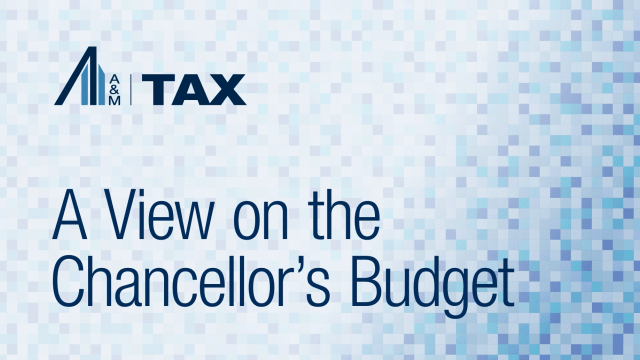A&M Taxand London Asset Managers Briefing Note: Volume 9
1. HM Treasury’s responses to the ‘Review of the UK Funds Regime: A Call for Input’
HM Treasury (“HMT”) published its ‘Review of the UK Funds Regime: A Call for Input’ in January 2021. The key objectives of the review were to look at options to boost the UK’s competitiveness as a location for asset managers and investment funds, and to support investments which were greater aligned to investors’ requirements.
We have summarised the main proposals included in HM Treasury’s Responses to the review to assist you in understanding potential changes and how A&M can help here.
2. Salaried Member Rules – HMRC communications to LLPs
We are aware of HMRC sending letters to LLPs regarding the salaried member rules, which became effective from 6 April 2014, as anti-avoidance legislation. Under the rules, an individual member of an LLP is treated as an “employee” for tax purposes provided conditions are met.
LLPs are “encouraged” in the letters to review their systems to ensure that salaried members are identified correctly. To the extent that the LLP may have failed to operate PAYE / NIC on salaried members, then a reply would be required. In some cases, we have seen HMRC issuing protective Regulation 80 determinations where they wish to collect unpaid income tax via PAYE.
Click here to learn more including the common issues we see clients face and how A&M can help.
3. New tax regime for Qualifying Asset Holding Companies – update
The legislation for this new tax regime including HMRC guidance has recently been published (found here), and a lot of interest is generated amongst clients for their existing and future fund structures.
Further to the initial release of the HMRC guidance, HMRC has clarified that some activities, especially related to credit strategies, should not, be considered trading which provides comfort to credit funds (and others). It is critical in order for an asset holding company (“AHC”) to fall within the regime that trading activities of the company must not be both ancillary to the company’s main investment business and not substantial.
It is set out in the guidance where an AHC originates a debt investment, rather than acquiring debt on the secondary market, this does not indicate trading.
HMRC also mentions fees – if a fund invests in loans, fee income originating from or on holding of these loans including execution, origination or participation fees, should be investment income. However, HMRC does clarify that fees for the arrangement of loans for others to hold i.e. syndication fees, are likely to be the result of trading activity.
A&M is here to work with you closely and can provide assistance in dealing with enquiries related to the new regime including, but not limited to the following:
- Reviewing the tax implications of your current or future fund structure and assessing whether there would be any impact if the relevant company/ companies are relocated to the UK under the new regime.
- Assisting with meeting the eligibility requirements to be a QAHC.
- Developing tax and reporting compliant approaches in relation to your current or future fund structures under the new regime or outside of it.
If you would like to discuss any of the above please feel free to get in touch with us.
4. Luxembourg signs new Double Tax Treaty with the UK
On 7 June 2022, Luxembourg and the UK signed a new double tax treaty (the “DTT”) and an additional Protocol. As expected, the main change is in relation to the taxation of Luxembourg entities with real estate investments in the UK, where the taxation of these is now aligned with other jurisdictions.
We have summarised the important changes to be introduced by the DTT found here.
5. Reward and Employment Tax issues and challenges employers may face, covering off-payroll working rules and employer compliance
We are delighted to share our a Reward and Employment Tax update series of articles which provide insight into employment tax issues and challenges employers may face.
Part 1: Off-Payroll working rules (“IR35”) expansion into the private sector – one year on
Part 2: IR35 – one year on
Part 3: Employer Compliance – Reporting Expenses and Benefits
Part 4: Employer Compliance – Reporting Employment Related Securities
Part 5: Looking Ahead to the New Tax Year
Part 6: Key changes for employers in 2022/23 - Looking ahead to the new tax year
Please contact Louise Jenkins or Tracey Norton if you have any questions related to any of these articles.
6. A reminder for Employment-Related Securities Annual Returns
We want to provide a further reminder that following the end of the 2021/22 UK tax year, asset managers that have awarded carried interest and co-investment entitlements should consider whether they need to report these awards on the ERS annual return.
The ERS annual return involves a number of key tasks, including:
- Registering new plans or arrangements;
- Verifying or self-certifying the tax-advantaged plans in place; and
- Submitting annual returns with all reportable events (including nil returns).
All ERS annual returns should be filed with HM Revenue and Customs on or before 6 July 2022 for 2021/22 tax year, with late filings resulting in an automatic penalty and potentially significant consequences for tax-advantaged plans.
If you need any assistance or if you are unsure whether you are required to file an ERS annual return for 2021/22, please do not hesitate to get in touch.
7. Guest article “The Banking Problem” from Douglas Graham, Finance Director of NCM Fund Services Limited
When working with fund managers who are launching a new fund NCM are often asked what will be the slowest part of the process. Historically, drawing up the various governing documents and agreeing the terms of the limited partnership agreement with investors was, as you would expect, the clear winner. Now, however, the opening of the fund bank account is by far and away the slowest element within the process and needs to be factored into any proposed timetable from the outset. The time lag between the legal entity being registered with Companies House and having a working online bank account can be significant, and in some case can take as long as four months.
With legal firms no longer keen to use their client account to take investor funds on fund closure, the delay in opening the fund bank account is causing, at best, stress or in many cases, a delay to the fund launch. This can have a knock-on impact on investors and early investments that the fund is looking to make. The factors at play in this sometimes tortuous process seem to be a combination of more stringent AML regulations, the nature of fund structures themselves; and the appetite and available resource within the traditional high street banks for dealing with less familiar ‘corporate’ accounts. An example of where we have seen increased diligence in recent years is the requirement to evidence source of funds and provide detailed tax and AML information on beneficial owners and significant controllers. Most banks also now wish a call or face to face meeting with the fund principals to discuss the use of the vehicle, projected volume of transactions and cash flows through the account. While these are the
right questions to ask, there appears to be a lack of urgency in processing the information collected as well as evidence of a disjointed approach which means it can take a disproportionate amount of time to get through this fact find stage.
In terms of fund structures, the LP or LLP is often set up with the beneficial owner being the General Partner or the designated members, respectively. At the point of fund launch, the new investors become the significant limited partners. By its very nature, the ownership of the fund can change significantly between submission of the bank account opening forms and the eventual account opening four months later. Service providers such as NCM therefore end up answering numerous banking queries with information that supersedes previous submissions and there is a challenge to assist the banks in understanding and reconciling these movements without filling out all the bank forms again. What makes this process even harder post covid is that email is now the preferred method of communication. With many banks working on a circa five day response time to emails this further delays the process.
There is some light at the end of the tunnel with new online providers entering the market. These tend to be historic or new FX businesses who have more of an appetite for the banking of fund structures and are designing their account opening process using IT platforms to streamline the end to end experience. Not surprisingly they do charge more but that must be weighed up against the desire to get the fund launched in order to facilitate the investment process.
In the meantime we suggest that managers start the process as soon as possible to avoid any disruption as they move towards that first close. It is also something managers should discuss with their legal advisors and fund administrators at the outset to ensure they are working on this to avoid absorbing management time during the fundraising period.





